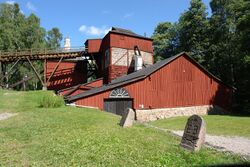Industrial heritage
Topic: Social
 From HandWiki - Reading time: 3 min
From HandWiki - Reading time: 3 min
File:Aerial imagery of Attisholz Areal Riedholz Switzerland.webm
Industrial heritage refers to the physical remains of the history of technology and industry, such as manufacturing and mining sites, as well as power and transportation infrastructure. Another definition expands this scope so that the term also covers places used for social activities related to industry such as housing, museums, education or religious worship, among other structures with values from a variety of fields in order to highlight the interdisciplinary character of industrial heritage.[1] It is also argued that it includes the so-called sociofacts or aspects of social and institutional organizations, and mentifacts that constitute the attitudinal characteristics and value systems industrial heritage sites.[2]
The scientific study of industrial remains is called industrial archaeology. The industrial heritage of a region is an aspect of its cultural heritage. It also forms part of a location's identity as it serves as evidence of progress and landmark achievements.[3] The international organization dedicated to the study and preservation of such is The International Committee for the Conservation of the Industrial Heritage, known as TICCIH. These initiatives are partly driven by an interest in innovation and ingenuity or efforts to compensate for irreparable loss.[3]
See also
- List of industrial archaeology topics
- List of notable industrial heritage sites
- Industrial archaeology
United Kingdom
- Anson Engine Museum
- Armley Mills Industrial Museum
- Blaenavon Industrial Landscape (Big Pit National Coal Museum and Blaenavon Ironworks)
- Bratch
- Industrial archaeology of Dartmoor
- Ironbridge Gorge Museum Trust
- Prestongrange Industrial Heritage Museum, East Lothian, Scotland
- Prickwillow Museum
- Rhondda Heritage Park
- Scottish Industrial Railway Centre
- Stretham Old Engine
Republic of Ireland
- Allihies Copper Mine Museum, County Cork
- Arigna Mining Experience, County Roscommon
- Bunnadober Mill, County Mayo
- Donegal Railway Heritage Centre, County Donegal
- Glengowla Mines, County Galway
- Newbridge Silverware, County Kildare
- Steam Museum, Straffan, County Kildare
Europe
- European Route of Industrial Heritage
- The Industrial Heritage Trail, Ruhr, Germany
- Ore Mountain Mining Region, Germany/Czech Republic
- Pythagoras Mechanical Workshop Museum, Norrtälje, Sweden
- Vizcaya Bridge, Biscay, Spain
Turkey
- SantralIstanbul, Istanbul
- Hasanpaşa Gasworks, Istanbul
- Bomonti Beer Factory, Istanbul
- Tersane Istanbul, Istanbul
- Fişekhane, Istanbul
Other regions
- Industrial heritage of Barbados
- Melbourne Steam Traction Engine Club, Australia
- Hagley Museum and Library, USA
- Sloss Furnaces, Birmingham, Alabama, USA
- Soulé Steam Feed Works, USA
- Asian Route of Industrial Heritage
- The Modern Industrial Heritage Sites in Kyushu and Yamaguchi, Japan
- The Tomioka Silk Mill and Related Industrial Heritage, Japan
References
- ↑ Douet, James (2016). Industrial Heritage Re-tooled: The TICCIH Guide to Industrial Heritage Conservation. Oxon: Routledge. pp. 232. ISBN 9781629582030.
- ↑ Xie, Philip Feifan (2015). Industrial Heritage Tourism. Bristol: Channel View Publications. pp. 59. ISBN 9781845415136.
- ↑ 3.0 3.1 Alfrey, Judith; Putnam, Tim (2003-09-02) (in en). The Industrial Heritage: Managing Resources and Uses. Routledge. ISBN 9781134912278. https://books.google.com/books?id=uPVGu-gfjl4C&dq=industrial+heritage+cultural&pg=PT48.
Further reading
- Douet, J, (ed.). Industrial Heritage Re-tooled: The TICCIH guide to Industrial Heritage Conservation. Lancaster: Carnegie. 2012. pp. 244 ISBN:978-1-85936-218-1
- Itzen, P., Müller, Chr. (eds), The Invention of Industrial Pasts: Heritage, political culture and economic debates in Great Britain and Germany, 1850-2010, Augsburg: Wissner. 2013. pp. 184 ISBN:978-3-89639-910-6.
- Oevermann, H., Mieg, H. A. (eds). Industrial Heritage Sites in Transformation: Clash of Discourses. London, New York: Routledge. 2014. pp. 222 ISBN:978-0415745284.
- Christian Wicke, Stefan Berger, and Jana Golombek (eds), Industrial Heritage and Regional Identities. London: Routledge. 2018. pp. 245ISBN:9781138241169.
External links
- "Industrial Heritage in All Regions", a list of links to industrial heritage sites in Great Britain, at Aboutbritain.com
- bih.ballarat.edu.au
- archeologiaindustriale.net, Project for the Italian Industrial Heritage promotion.
- Asturian industrial heritage
 |
 KSF
KSF




